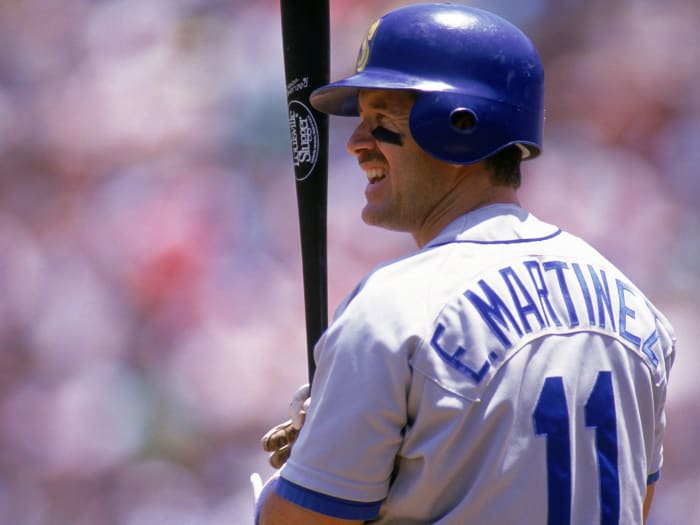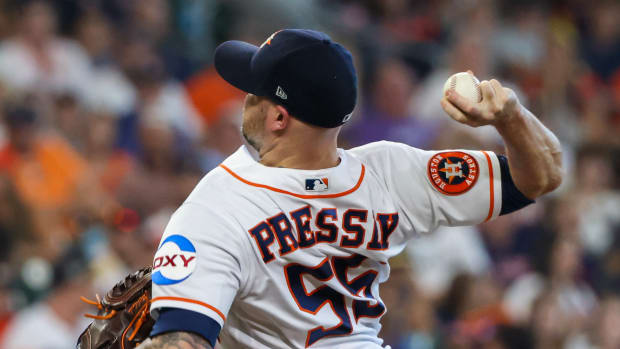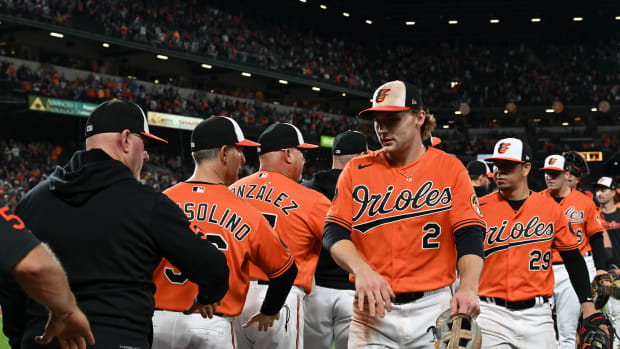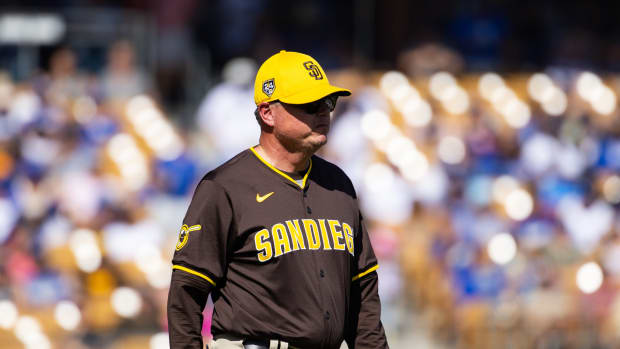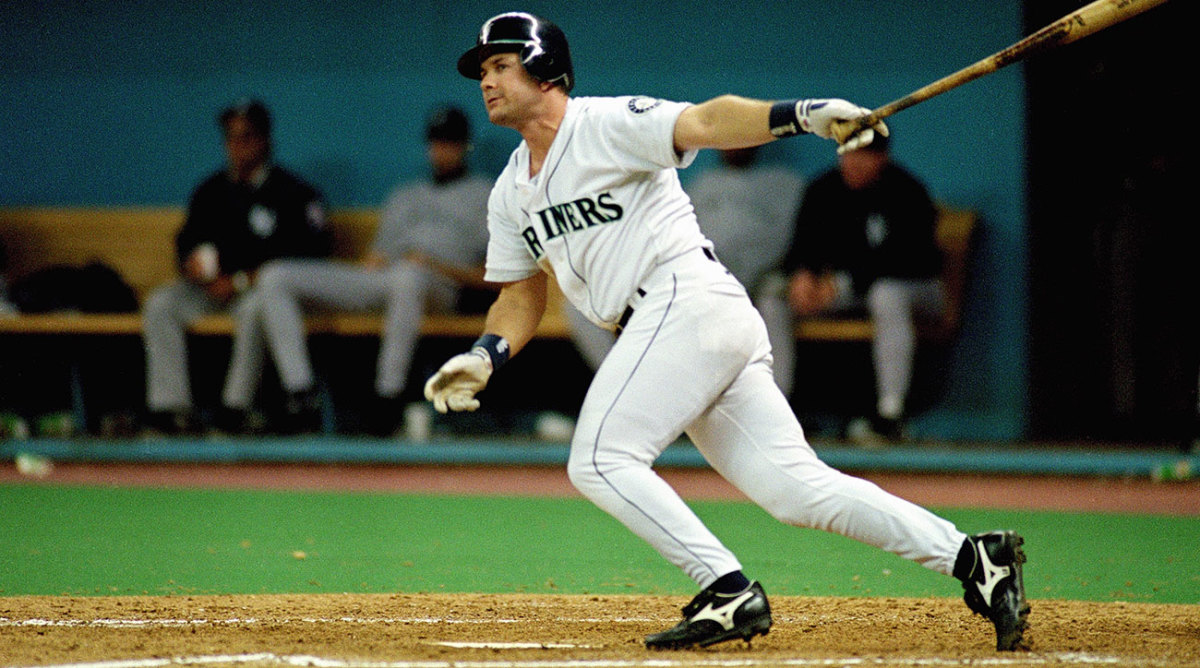
JAWS and the 2017 Hall of Fame ballot: Edgar Martinez
The following article is part of my ongoing look at the candidates on the BBWAA 2017 Hall of Fame ballot. Originally written for the 2013 election, it has been updated to reflect recent voting results as well as additional research. For a detailed introduction to this year's ballot, please see here. For an introduction to JAWS, see here.
All Edgar Martinez did was hit—a statement that is almost completely true in both the literal and figurative senses. Even after adjusting for his high-scoring surroundings, Martinez could flat-out rake. A high-average, high-on-base percentage hitting machine with plenty of power, his numbers place him among the top 30 or 40 hitters of all time even after adjusting for the high-offense era. Martinez played a key role in putting the Mariners on the map as an American League West powerhouse, emerging as a folk hero to a fan base that watched Ken Griffey Jr., Randy Johnson and Alex Rodriguez lead the franchise's charge to relevancy, then force their ways out of town over contract issues. But while Griffey and Rodriguez were two-way stars at key up-the-middle positions and Johnson was a flamethrowing ace, Martinez spent the bulk of his career as a designated hitter. In that capacity, he merely put a claim on being the best one in baseball history.
More than four decades after it was introduced—in the most significant rule change since the AL adopted the foul strike rule in 1903—the DH continues to rankle purists who would rather watch pitchers risk injury as they flail away with ineptitude (Bartolo Colon excepted). Not until 2014 was the first player ever to spend a majority of his career as a DH inducted into the Hall of Fame: Frank Thomas, who made 57% of his plate appearances in that capacity. Thomas's election came a full decade after Paul Molitor became the Hall’s first player to spend the plurality of his career (44%) as a DH after bouncing all around the infield. By comparison, Martinez took 72% of his plate appearances as a DH; David Ortiz—whose 2016 victory lap spurred plenty of Hall of Fame discussion—took 88%.
When I reviewed Molitor's Hall of Fame case in 2004 (in my Baseball Prospectus debut, at a point when my system wasn't even called JAWS), I considered him as a third baseman because he had spent 788 games there and the majority of his games playing somewhere in the infield. He had generated real defensive value (26 Fielding Runs Above Average according to the measure of the time), strengthening a case that was virtually automatic by dint of his membership in the 3,000 hit club. I have maintained that precedent in examining other candidates who spent good chunks of their careers at DH—mainly outfielders (Harold Baines, Jose Canseco, Chili Davis) with superficially impressive counting stats but no real shot at gaining entry to Cooperstown—in part because JAWS enables easy comparisons with Hall of Famers not only at a given position but also with the at-large field of enshrined hitters. I've stuck to that precedent in examining the case of Martinez, who ranks fourth on the all-time list for games by a DH at 1,403 but also played 564 games at third base and another 28 at first base.
I've compared Martinez to the Hall's third basemen, corner infielders and hitters in general, mainly because when properly used, JAWS is a tool used to build an argument, not answer a simple yes/no question. Within its positional adjustments, which account for the differing degrees of difficulty along the defensive spectrum, the Wins Above Replacement system levies in a substantial penalty for not playing the field. But even with that penalty incorporated into his annual WAR and even after he got such a late start (his first season playing at least 100 games didn't come until age 27), Martinez measures up as valuable enough to merit a bronze plaque. A two-time batting champion and a seven-time All-Star, he posted eye-opening numbers even in an era full of them and created enough value even while riding the pine between trips to the plate to score better than many of the current ballot's more celebrated position players.
But since making a solid debut on the 2010 ballot with 36.2% of the vote, Martinez has had a hard time expanding his base of support. After plunging into the mid-20s as the ballot grew more crowded, his candidacy appeared dead in its tracks, particularly given the Hall’s 2014 rule change, which truncated his eligibility from 15 years to 10. But still there’s hope. He vaulted from 27.0% in 2015 to 43.4% in ’16, his seventh year of eligibility, and while making up the remaining ground over three election cycles is a tall order, falling short with at least 50% or even 60% would still bode well for eventual enshrinement. This hitting machine hasn’t taken his last at-bat.
player | career | peak | jaws | h | hr | sb | avg/obp/slg | ops+ |
Edgar Martinez | 68.3 | 43.6 | 56.0 | 2,247 | 309 | 49 | .312/.418/.515 | 147 |
Avg. HOF 3B | 67.5 | 42.7 | 55.1 |
|
|
|
|
|
Avg. HOF CI | 66.0 | 42.4 | 54.2 |
|
|
|
|
|
Avg. HOF hitter | 67.1 | 42.2 | 54.6 |
|
|
|
|
|
Martinez was born in New York City in 1963 but was raised by his maternal grandparents in the Maguayo neighborhood of Dorado, Puerto Rico, as his parents divorced shortly after he was born. He grew up three houses away from his cousin Carmelo Martinez, a major leaguer from 1983 to '91. Martinez's parents remarried when Edgar was 11, but he chose to remain with his grandparents. By then, he'd caught the baseball bug, drawn to the game by the heroics of Puerto Rican icon Roberto Clemente. He honed his swing with a broomstick, obliterating bottle caps, rocks and even droplets of water as they fell from the roof.
In 1982—eight years before MLB made Puerto Rico subject to the amateur draft—a nearly 20-year-old Martinez was making $4 an hour on an assembly line at a pharmaceutical plant, taking classes at American University in San Juan and playing semipro ball on the weekends when Mariners scout Marty Martinez (no relation) signed him for a $4,000 bonus. Old by prospect standards, he hit just .173/.304/.202 in 126 plate appearances for Seattle's Northwest League affiliate in 1983 but quickly improved. He broke out in his age-24 season in 1987, hitting .329/.434/.473 at Triple A Calgary.
Blocked at third base by Jim Presley, a one-tool player whose eight major league seasons and 135 homers amounted to 0.2 WAR, Martinez had to settle for cups of coffee from the Mariners in 1987 and '88. After opening the ’89 season as the starter in Seattle, he struggled so mightily (.240/.314/.304 in 196 plate appearances) that he was briefly sent back down. He stuck in the majors for good in 1990, hitting .302/.397/.433 for a 133 OPS+. The Total Zone system estimates that his defense at the hot corner was 13 runs above average, giving him a hefty 5.5 WAR that season, good for seventh in the league. A year later, Martinez hit .307/.405/.452—the first of 11 seasons with an OBP above .400—and helped the Mariners crack .500 for the first time in franchise history. Again he was above average defensively (+6 runs) en route to 6.1 WAR, eighth in the league.
JAWS and the 2017 Hall of Fame ballot: Curt Schilling
In 1992, Martinez won his first AL batting title, hitting .343/.404/.544 with a league-leading 46 doubles, and his 6.5 WAR tied for fifth in the league, though his season ended about three weeks early due to a bone spur in his right shoulder that required surgery. His woes were just beginning, as he was limited to a total of 131 games over the next two seasons due to hamstring and wrist injuries as well as the players' strike. In '94 Seattle to relieved him of his defensive responsibilities; although Martinez was seven runs above average at the hot corner, the Mariners needed his bat far more than his glove. Over the remaining decade of his career, he would play just 34 more games in the field, never making more than seven starts in a season, usually in interleague road games.
The decision paid off. In 1995, even while donning his mitt for just seven games, Martinez set a career-high with 7.0 WAR, good for second in the league. He hit .356/.479/.628, leading the league in batting average, on-base percentage, OPS+ (185) and doubles (52) and helping Seattle to its first playoff berth. He was a one-man wrecking crew in the Division Series against the Yankees, batting .571/.667/1.000 with four three-hit efforts and reaching base safely 18 times in five games. Martinez is still the co-holder of the record for most hits in a Division Series (12), and his 21 total bases rank fifth. Meanwhile, The Double (as it's remembered in the Pacific Northwest) that he hit in the 11th inning of the decisive Game 5 scored the tying and winning runs and is on the short list of hits that have taken on lives of their own. The euphoria of that moment helped generate the groundswell of support that secured the Mariners a new taxpayer-funded stadium within a week of the series ending. In 2004, the city of Seattle renamed one of the streets leading to Safeco Field "Edgar Martinez Drive."
The 1995 season began a seven-year stretch in which Martinez hit a combined .329/.446/.574 and averaged 42 doubles, 28 homers, 107 walks and 5.8 WAR per year (40.6 total). He led the AL in on-base percentage again in 1998 (.429) and '99 (.447) after finishing second with even higher figures in '96 (.464, behind Mark McGwire's .467) and '97 (.4558 to Thomas's .4561), and placed third in OPS+ three straight times ('96 to '98) before falling to fifth or sixth in the next three seasons. During that span, he was the second-best hitter in baseball, at least based on the batting component of WAR; his 380 runs above average trailed only Barry Bonds’s 443.
Defensive value is built into WAR in two ways: by estimating a player’s relative value (runs above or below average via Total Zone or, from 2003 onward, Defensive Runs Saved); and with positional adjustments that change over time to account for skill required to play the position, based largely on the distribution of balls in play. In the baseball-reference.com version of WAR, a full season at third base has a value of +2 runs, which is to say that showing up for work and filling that spot without burning down the stadium is worth two extra runs beyond average. By comparison, a full season at DH has a value of -15 runs, so it takes an extra 17 runs per year for an average fielder at the hot corner to offset such a move with his bat.
In other words, the “But he was a DH, not a complete player!” sentiment is baked into the valuations, and even while being docked 13 or 14 runs per year due to his time at DH (he played just 33 games at third and first in that span), Martinez tied with Sammy Sosa as the majors' fifth-most valuable position player from 1995 to 2001, behind Bonds (56.7), Rodriguez (46.6), Jeff Bagwell (44.8) and Griffey (41.0). The Griffey comparison is particularly startling: The centerfielder on those Mariners teams won an MVP award and four Gold Gloves during that stretch and led the AL in homers for three years in a row (twice with 56)—and he was more valuable than Martinez by an annual margin of roughly half a run.
JAWS and the 2017 Hall of Fame ballot: Trevor Hoffman
Seattle reached the playoffs again in 1997, 2000 and in '01, tying the MLB record in the latter season with 116 wins despite not having Johnson, Griffey or Rodriguez, all of whom had departed. Even in his age-38 season, Martinez was hardly window dressing on that team, hitting .306/.423/.543 with 40 doubles, 23 homers, a 160 OPS+ (fifth in the league) and 4.8 WAR. He played three more seasons, hitting well for two of them, before retiring. On Oct. 3, 2004, in a ceremony after Martinez played his final game, commissioner Bud Selig showed up to announce that the annual Outstanding Designated Hitter Award, which he had won five times, would be renamed in his honor.
Martinez isn't the first Hall of Fame candidate to benefit from spending his twilight years as a DH. Molitor reached the 3,000-hits plateau and Cooperstown largely because of what he did there, and likewise for Thomas and the 500-homer benchmark. George Brett's 3,000th hit and the 500th home runs of Reggie Jackson, Eddie Murray and Jim Thome all came when they were serving as DH; 101 of Jackson's 573 dingers, 92 of Murray's 504 and 205 of Thome's 612 (including No. 600 as well) came in that capacity. Nonetheless, Martinez's case is an interesting test for the voters. He played so few games in the field not only because he established himself at a relatively advanced age but also because the risk/reward payoff wasn't merited once he emerged as an elite hitter (though it's likely the Mariners could have stuck him at first base—a much easier position than third, requiring less mobility—had they so desired).
It's also worth considering that Martinez played in an era of increased specialization, particularly regarding bullpen roles. Teams concerned with the limitations of a pitcher's stamina, health and/or repertoire often convert starters to relievers, who rarely produce enough value within their smaller roles to merit consideration for the Hall. Mariano Rivera is the best example; it's quite possible he'd have never approached a Hall of Fame level had he remained a starter. Martinez was the Mariano Rivera of DHs: He was so good within his limited role that he produced enough value to transcend it.
(By the way, Martinez owned Rivera: .579/.652/1.053 in 23 plate appearances. The great reliever told Charlie Rose in 2013: "The only guy that I didn't want to face, when a tough situation comes, was Edgar Martínez.... It didn't matter how I threw the ball. I couldn't get him out. Oh my God, he had more than my number. He had my breakfast, lunch and dinner.")
In terms of the numbers he put up only as a DH, Martinez ranks third in hits (1,607) behind Ortiz (2,191) and Baines (1,690). He’s third in home runs (243) behind Ortiz (485) and Thomas (269), second in doubles (370 to Ortiz’s 557) and total bases (2,718 to Ortiz’s 4,239). His .959 OPS at the position (on .314/.428/.532 hitting) tops Ortiz’s .942 (.289/.383/.559) and every other player with at least 2,000 plate appearances in that role, and that’s without considering the relative impacts of their ballpark. In terms of overall OPS+ at all positions—important, as it adjusts for the differing park and league scoring environments—Martinez has the edge on Ortiz, 147 to 141, not to mention a roughly 13-win edge in terms of WAR (68.3 to 55.4) in 1,417 fewer career plate appearances. Prorated, Martinez produced 5.1 WAR per 650 plate appearances compared to Ortiz’s 3.6 WAR—a 43% advantage for Edgar even before career length is considered. Even with that substantial penalty built into WAR for the last decade of his career—roughly 1.5 wins per year!—Martinez ranked among the AL’s top 10 in WAR seven times; by comparison, Ortiz did so three times.
JAWS and the 2017 Hall of Fame ballot: Tim Raines
What’s more, Martinez created enough value as a hitter to surpass the career, peak and JAWS standards among Hall of Fame third basemen by about one win apiece, ranking 11th among third basemen on the latter front. He’s 1.5 points behind Molitor, but with a peak that’s four wins higher. The margin between Martinez and the field is slightly larger when you expand the comparison to enshrined corner infielders (first and third base) or all hitters (with catchers given a boost to put them on the same scale as the other positions), as noted in the table up top.
All of that is without factoring in the late start to his major league career. From his age-27 season onward, Martinez created more value (67.6 WAR) than all but 20 position players, 19 of whom are in Cooperstown; Bonds is the lone exception. Of the top 35 on that list, only A-Rod, Bonds, Chipper Jones, Pete Rose and the still-active Adrian Beltre and Ichiro Suzuki aren't already enshrined. Throw in the black and gray ink (two batting titles and a second-place finish; three OBP titles and three second places; one OPS+ lead and six top-five finishes), seven All-Star appearances, his all-time rankings in OBP (12th among hitters with 7,000 plate appearances), OPS+ (27th) and WAR batting runs (34th) as well as the impact of the 1995 postseason upon Seattle baseball history, and his case is strong enough to push him even further over the line.
Voters have been slow to come around to that conclusion, though Martinez does have a substantial bloc of support. Four years into his eligibility, he was nearly halfway there, reaching 36.5% in 2012, and after getting lost in the shuffle in the next two years (with 25.2% in '14 and 27.0% in '15) he jumped by 16.4%—the cycle’s second-largest gain—to 43.4%. That’s not a lost-cause level in terms of modern voting history (since 1966, when the BBWAA returned to annual voting): Bert Blyleven (35.4%), Bruce Sutter (38.5) and Duke Snider (41.0) all fared even worse in their seventh years of eligibility and were eventually elected by the writers. The rub is that all three needed more time than Martinez has left on the ballot thanks to that 2014 rule change, which reduced the maximum number of years on the ballot from 15 to 10 (three players were grandfathered in and allowed to stay for 15 years). Snider was elected in in his 11th year, Sutter his 13th and Blyleven his 14th. After Tim Raines, Martinez may be the candidate harmed the most by the change, because his only path to election was a long, slow building of consensus.
It would be a shame if Martinez had to wait decades for such recognition. He was clearly one of the best hitters in baseball, not only of his era but also of all time. Though the bulk of his career was spent as a designated hitter, advanced metrics show that his superiority with the bat transcended the role. He was more valuable than the average Hall of Fame position player and more valuable than a handful of players who reached the 500 home run or 3,000 hit milestones in much longer careers. His 68.3 WAR is the same as one of the five players who have both, Eddie Murray—and Murray had 48% more plate appearances. Edgar Martinez belongs in Cooperstown.






























